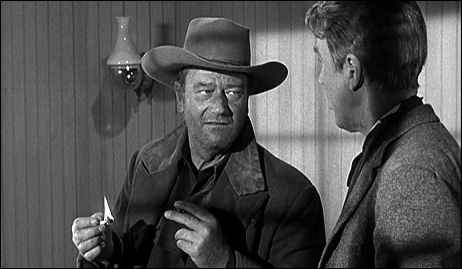In tribute to tonight’s BAM screening of John Ford‘s The Man Who Shot Liberty Valance (as part of the New York Film Critics Circle 1962 series), the New Yorker‘s Richard Brody has assembled a video piece and written a few words, among them a declaration that it’s “both the most romantic of Westerns and the greatest American political movie.
“The Western is intrinsically the most political movie genre, because, like Plato’s ‘Republic,; it is concerned with the founding of cities, and because it depicts the various abstract functions of government as direct, physical actions. It’s also an inherently romantic genre, because of its connection with the nation’s founding mythology. (One of the strengths of Ford’s movie is its depiction of the actual grassroots practical politicking in the Western territories.)
“The movie’s most famous line, of course, is that of a newspaperman: ‘This is the West, sir. When the legend becomes fact, print the legend.’ Ford prints it — and prints the facts behind it — and makes a movie about the moral burden of a life lived in the name of a myth and the ethical implications of direct action. Implicitly, the subject of the film is also that of a nation founded in this way. In his next Western, Cheyenne Autumn, from 1964, Ford takes on another overlooked Western reality: that of the Native Americans and their relations with the United States government.
“But the movie is also romantic in another, intimate way — it’s a great love story and a painful triangle, involving the tenderfoot lawyer (James Stewart), his gunslinger friend (John Wayne), and the woman they both love (Vera Miles). The tale’s epic span — it’s framed as a flashback to distant youth — stretches that love story over a vast arc of experience and renders it immeasurably poignant.
“As it draws to a close, there’s hardly a dry eye in the house — at least, in our house.”
I wrote about 15 months ago that I didn’t like The Man Who Shot Liberty Valance “as much as I should because of the TV sound stage vibe, the hamminess of the acting, the fact that John Wayne and Jimmy Stewart are at least 15 years too old for their parts, etc.”

John Wayne, James Stewart
I also wrote the following in July 2007: “You can talk about this film for hours and never run out of new things to discover or re-review. I’ve seen Liberty Valance many, many times on the tube, and I absolutely love the transfer on the most recent DVD. It’s basically an old man’s movie — an elegy for bygone times and regrettably false legends. There’s also no denying it’s one of Ford’s very best — his saddest and most personal film ever, and worthy of the highest respect.
“But the older I’ve gotten (and I’ve said this before), the more trouble I’ve had with Ford’s sentimental cornball streak. His affection for actorly colorfulness among his supporting players seems to get worse every time I re-watch one of his films. Andy Devine‘s performance in Liberty Valance as a cowardly, squealy-voiced sheriff is, for me, 90% torture . (His one good scene is in the very beginning when he takes Vera Miles out to visit Wayne’s burned-down ranch.) Edmond O’Brien‘s alcoholic newspaper editor is a problem performance also. The movie is littered with them.
“As Newsweek critic Malcom Jones observed in March 2006, Ford’s movies “are a little antique, a little prim.”
“The irony, of course, is that despite the irritating aspects, The Man Who Shot LIberty Valance becomes a greater and greater film with each re-viewing. Some- thing majestic and touching and compassionate seems to come out in greater and greater relief. Genius-level films always gain over the years, but to my surprise I was almost moved to tears last night — and this stagey monochrome oater has never quite melted me before. Go figure.”












